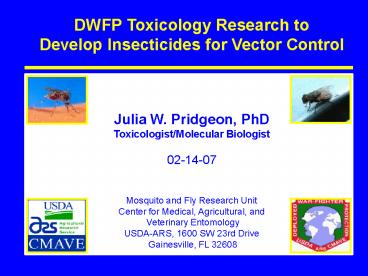DWFP Toxicology Research to - PowerPoint PPT Presentation
1 / 18
Title:
DWFP Toxicology Research to
Description:
DWFP Toxicology Research to Develop Insecticides for Vector Control Julia W. Pridgeon, PhD Toxicologist/Molecular Biologist 02-14-07 Mosquito and Fly Research Unit – PowerPoint PPT presentation
Number of Views:106
Avg rating:3.0/5.0
Title: DWFP Toxicology Research to
1
DWFP Toxicology Research to Develop Insecticides
for Vector Control Julia W. Pridgeon,
PhD Toxicologist/Molecular Biologist 02-14-07 Mo
squito and Fly Research Unit Center for Medical,
Agricultural, and Veterinary Entomology USDA-ARS,
1600 SW 23rd Drive Gainesville, FL 32608
2
Research Objective
To discover and develop effective chemical and
molecular insecticides for vector control
3
Military Relevance
? In military units, arthropod-borne diseases
continue to be serious threats to deployed troops
? Chemical pesticides are the most effective way
to control disease vectors, however, few products
are available for military use ? Due to the
nature of military operations, pesticides that
can quickly and effectively eliminate arthropod
vectors are highly desirable
4
Approach for the Development of Effective
Chemical Insecticides
Registered Pesticides
Natural Plant Chemicals
Plant Extracts
Designer Chemicals
USDA-ARS- NPURU
USDA-ARS- MFRU
NPURU UF
IRAC
High-Throughput Screen to find highly toxic
chemical (Topical application Aedes aegypti
model)
Small Chamber Test and Field Evaluation
5
Topical Application
Small Amount
Fast
Easy
Accurate
6
Results of Studies on Chemical Insecticides
Registered Pesticides
Natural Plant Chemicals
Plant Extracts
33 Designer Chemicals
26
19
33
USDA-ARS- MFRU
USDA-ARS- NPURU
NPURU UF
IRAC
Pesticide LD50 (ug) Fipronil 1.3
?10-6 Permethrin 1.4 ?10-4 Spinosad 2.5
?10-3 Bifenzate 4.25
AT-05-27-2 (LD50? 0.3ug) 123-1 (LD50 0.4ug)
Bacopa monnieri (Water hyssop) Methanol
Extract LD50 ?125ug
LD50 0.8ug
LD50 2.1ug
LD50 14.72ug
7
Summary on Studies of Chemical Insecticides
- Screened 19 registered pesticides several showed
high insecticidal activity against Aedes aegypti - Screened 26 different natural plant chemicals
(NPURU) two had relatively high toxicities
8
Summary on Studies of Chemical Insecticides
3) Screened 33 different plant extracts (MFRU),
some had higher toxicity against mosquitoes than
others 4) Screened 33 piperidines with different
structures (UF and NPURU), 2-ethyl piperidines
showed the highest toxicities against mosquito
(in press in Journal of Medical Entomology)
9
Future Studies on Chemical Pesticides
- Evaluate the toxicities of registered pesticides
against different species of mosquitoes and other
disease vectors - Select the best pesticide candidates for further
evaluation in small chamber tests and field
studies - Manipulate the structures of plant chemicals and
evaluate their toxicities
10
Future Studies on Chemical Pesticides
4) Studies on toxicity of plant extracts will be
continued (additional information by Dr. Quinn)
5) For structure-activity analysis, different
classes of chemicals will be evaluated and the
best ones chosen for further structure
manipulation
11
Approach for the Development of Molecular
Pesticides
Target Essential Pathways
Molecular Cloning (DNA, RNA, PCR)
Programmed Cell Death, Mitochondria Pathway,
etc
(Aedes aegypti model)
Vector, Carrier, Formulation
Molecular Pesticide Construction
(Aedes aegypti model)
12
Evaluation of Molecular Pesticides
Cell Assay
Control
Molecular Pesticide 1
Molecular Pesticide 2
Molecular Pesticide 3
13
Evaluation of Molecular Pesticides
Adult Assay
Control
Molecular Pesticides
14
Summary Development of Molecular Pesticides
- Cell and adult assays have demonstrated that
critical pathways can be targeted to develop
molecular pesticides - Using Aedes aegypti as a model organism,
molecular pesticides are effective and
fast-killing (within 6 hours)
15
Future Studies Development of Molecular Pesticides
- Identify new critical pathways to target
- Produce additional molecular pesticides and
evaluate their efficacy - Select best molecular pesticides and evaluate
production and application methods (formulation,
carriers, etc)
16
Overall Summary
- Screened known registered pesticides several
showed high insecticidal activity - Screened different natural plant chemicals
(NPURU), two had relatively high toxicities
against mosquitoes
17
Overall Summary (Contd)
3) Screened 33 piperidines (UF NPURU) with
different structures, 2-ethyl piperidine showed
the highest toxicity (in press in JME) 4) Cell
and adult assays have demonstrated that critical
pathways can be targeted to develop molecular
pesticides (patent pending) 5) Using Aedes
aegypti as a model organism, molecular pesticides
are effective and fast-killing (within 6 hours)
18
Acknowledgments
Dr. Liming Zhao Heather Furlong Greg Allen Nathan
Newlon Joyce Urban
Dr. James J. Becnel Dr. Gary G. Clark Dr. Sandra
Allan Dr. Dan Kline Dr. Ulrich Bernier
Dr. Brian Quinn Dr. Chris Geden Dr. Roberto
Pereira Dr. Jerry Hogsette Dr. Ken Linthicum
Mosquito and Fly Research Unit, USDA-ARS-CMAVE
Dr. Kumudini Meepagala
Natural Products Utilization Research Unit,
USDA-ARS
Dr. Daniel Strickman
National Program Leader, Program 104, USDA-ARS
Dr. Alan Katritzky
Department of Chemistry, University of Florida
Dr. Graham White
Department of Entomology, University of Florida
Deployed War-Fighter Protection Research Program































